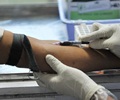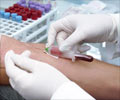- Newer drugs called direct acting antivirals (DAA) have revolutionized the treatment of hepatitis C
- A systematic review showed that these drugs are safe as well as effective in the treatment of hepatitis C
- The addition of ribavirin improves the efficacy, but also increases the mild-to-moderate side effects
For HCV 1 genotype:
- Grazoprevir–Elbasvir
- Paritaprevir–Ritonavir–Ombitasvir and Dasabuvir
- Sofosbuvir and either Simprevir, Daclatasvir, Ledipasvir or Velpatasvir
- Sofosbuvir and either Daclatasvir or Velpatasvir
- Sofosbuvir and either Daclatasvir, Ledipasvir or Velpatasvir
- Grazoprevir–Elbasvir
- Paritaprevir–Ritonavir–Ombitasvir
- Sofosbuvir and either Simprevir, Ledipasvir or Velpatasvir
- Sofosbuvir and either Ledipasvir or Velpatasvir
- The DAA combinations used for HCV genotype 1 infection showed high sustained virologic response (SVR) rates of more than 95% in patients without cirrhosis. These included patients with HIV infection. SVR refers to the absence of viral RNA in the blood at least 12 weeks after the completion of the treatment.
- Only 2 DAA regimens, Velpatasvir–Sofosbuvir and Daclatasvir-Sofosbuvir, are available for the treatment of HCV genotype 3 infection, though it is the second most common cause of HCV infection. Among these, the Velpatasvir–Sofosbuvir combination appears to be more effective in patients without cirrhosis.
- The SVR rates were slightly lower in patients with hepatic decompensation. According to current recommendations, these patients did not receive NS3 protease inhibitors like Simeprevir, Paritaprevir or Grazoprevir. They received treatment with Sofosbuvir and either Daclatasvir, Ledipasvir, or Velpatasvir. Side effects in this group of patients was higher than those in other groups.
- The addition of Ribavirin to certain DAA regimens improved the SVR rates, especially in patients with genotype 1a or 3 infection, cirrhosis, or prior treatment experience. However, ribavirin increased the incidence of mild-to-moderate adverse events like anemia, fatigue, and insomnia.
- Treatment with DAA regimens, especially with Velpatasvir–Sofosbuvir, for 12 weeks was effective in other genotypes like 2, 4, 5, or 6.
- The regimes are relatively safe with a relatively low incidence of serious adverse events and treatment discontinuation, even in patients with cirrhosis and HIV infection.
Reference:
- Falade-Nwulia O, Suarez-Cuervo C, Nelson DR, Fried MW, Segal JB, Sulkowski MS. Oral Direct-Acting Agent Therapy for Hepatitis C Virus Infection: A Systematic Review. Ann Intern Med. 21 March 2017















